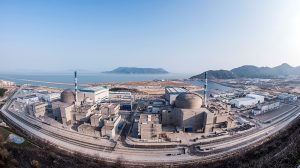On November 28 Radio France International Chinese published claims by a whistleblower contradicting official statements downplaying the extent of damage to fuel rods at the Taishan 1 Nuclear Reactor in Taishan, Guangdong province.
The whistleblower, who works at a French nuclear energy company, warned that more than 70 fuel rods were damaged, 14 times the figure acknowledged by China’s Ministry of Ecology and Environment (MEE) in June, when it stated “about five” rods were damaged. Additionally, the whistleblower claimed the damage may be linked to a “design flaw.”
Under pressure from public activism, France’s nuclear energy regulator, Autorité de sûreté nucléaire (ASN), yesterday announced it would halt the development of the EPR reactor at Flamanville in Normandy, which uses the same design as Taishan, pending inquiries into the malfunctions at Taishan.
“There is still a lot of work to be done on the [Flamanville] site before start-up operations, and feedback from the experience of the Taishan 1 EPR deviation must take place,” said ASN deputy general manager Julien Collet yesterday.
Located 110 kilometers south of Guangzhou, Taishan is the site of the world’s first reactors of the Evolutionary Power Reactor (EPR) design to commence operation. Its two reactors are capable of generating 1,750 Megawatts electric (Mwe) each.
According to the whistleblower, the problem of the Taishan EPR reactor is “a not-very-successful hydraulic system at the bottom of the vessel which gives an uneven distribution of power in the assemblies. A transverse current is created in the core and causes the assemblies to move, especially those at the periphery.”
The whistleblower’s claims were relayed by Bruno Chareyron, director of the Commission for Independent Research and Information about Radiation (CRIIRAD), a Paris-based NGO established in 1986 to monitor radioactive leaks in the wake of the Chernobyl disaster.
If the whistleblower came forward in person, they would likely lose their job, Chareyron told The Diplomat in an interview.
Following consultation with the whistleblower, CRIIRAD sent an open letter to the president of ASN, France’s nuclear energy regulator. The letter states that if the whistleblower’s concerns about Taishan 1 are borne out, the design flaw could compromise safety at other reactors of the EPR design, including Taishan 2, which is still operating, and the Flamanville EPR under construction in Normandy.
“At Taishan, the flow of water was not distributing in a proper manner, and the assemblies of nuclear fuel were having vibrations and shocks, which damaged them,” Chareyron said.
“There are at least three consequences. One is the fact that due to the damage to the nuclear fuel, a significant amount of radioactive substances migrate across the cladding of the rods and is go into the water of the primary circuit,” according to Chareyron.
“So radioactive gases like krypton and xenon are accumulating in the water inside the pressure vessel… Those gases are collected into tanks and those tanks are opened to the atmosphere normally every two months. But with fuel rod damage, some of the gases released have half-lives of years, like Krypton 85.”
He continued: “[The] second problem is the impact on the people working in the plant. Because if you have such damage in the core of the reactor, you contaminate the water inside the pressure vessel, but some of this contamination will stay inside the tubes, the pipes, the pumps.
“So when the operators have to conduct maintenance, they receive much more radiation than if the cladding fitted properly.”
Finally, “The third problem is if the fuel assemblies are a little bit broken, it means that you may reach a situation when, for example, in case of an earthquake, you cannot insert the control rods into the fuel assemblies because the assemblies are damaged,” Chareyron said.
Professor Yi-chong Xu of Griffith University in Brisbane, Australia, author of “The Politics of Nuclear Energy in China,” believes that while the Taishan incident is a setback, nuclear power still has a strong future in China.
“China has been building its domestic expertise. It can now build ‘Generation 3’ reactors independently, one of the few countries to do so,” said Xu. “China’s Hualong 1, which began operation this year in Fujian, is competitive with other Generation 3 models such as the U.S. Westinghouse AP1000, South Korea’s APR-1400, and France’s EPR.”
“Long term, China is also working to become an industry leader in what are called ‘Small Modular Reactors,’ which would be more feasible for China’s internal provinces. The safety zone of large nuclear power plants is about 8–10 kilometers [5–6.2 miles]. But a small modular reactor doesn’t need that, it needs less than a kilometer. China’s modular reactor prototype the ACP100 began construction this year in Hainan,” Xu said.

































